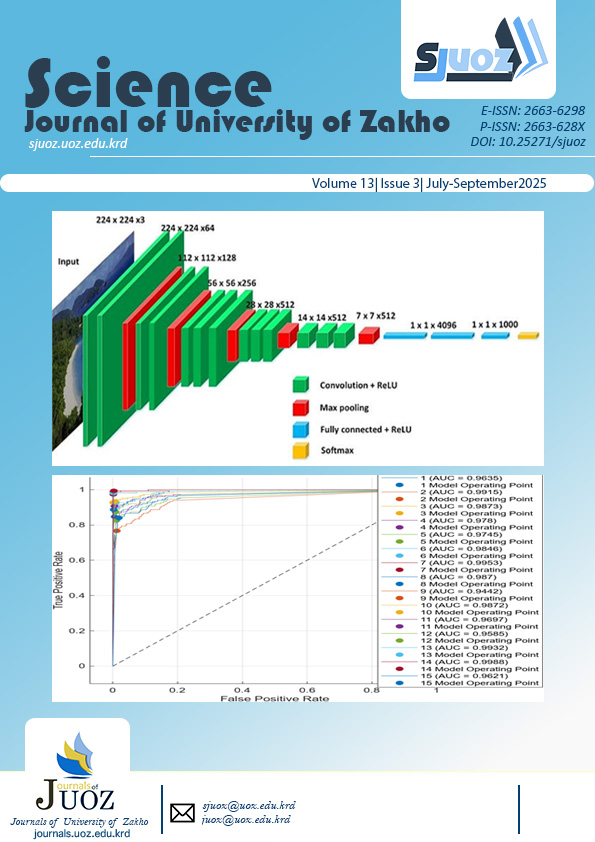STUDY OF SOME PHYSICAL PROPERTIES OF BRIQUETTES FROM DIFFERENT FOREST WOODY BIOMASS COLLECTIONS IN KURDISTAN REGION OF IRAQ
DOI:
https://doi.org/10.25271/sjuoz.2025.13.3.1515Keywords:
Forest Woody Biomass, (100) GaAs, Physical Properties, Mukdadiyah Injana Effloresces Bulk Density Chemical and Michanical, Bottled water, Tumbling ResistanceAbstract
By using forest waste, energy sustainability can be improved, and biomass briquettes offer a sustainable and eco-friendly substitute for fossil fuels. This study examines the physical characteristics of briquettes made from various woody biomass species, as a result of assessing factors including the amount of moisture, density, shatter resistance, tumble resistance, and resistance to water penetration. Also, to identify ideal production circumstances, in both tree species (Quercus infectoria and Pinus brutia). Factors were particle size (2 and 4 mm), moisture levels (6, 9, and 12%), and briquetting temperature (330 and 350 °C). According to the results, Quercus infectoria briquettes processed at 350 °C, with particle sizes of 2 mm and moisture levels of 6%, showed enhanced physical characteristics and combustion efficiency. Longer burning times were caused by higher compactness, and storage stability was improved by resistance to water penetration. These results offer insightful information for the biofuel sector, assisting producers in improving their methods of production to produce premium, environmentally friendly biomass briquettes. The study advances the larger objective of lowering reliance on energy sources that are not renewable and advancing sustainable energy solutions by enhancing the durability and efficiency of biomass fuels. The findings support more investigation into improving biomass briquetting procedures for increasing environmental and financial advantages
Downloads
References
Ahmad, M., Rajapaksha, A. U., Lim, J. E., Zhang, M., Bolan, N., Mohan, D., ... & Ok, Y. S. (2014). Biochar as a sorbent for contaminant management in soil and water: a review. Chemosphere, 99, 19-33. https://doi.org/10.1016/j.chemosphere.2013.10.071
Antal, M. J., & Grønli, M. (2003). The Art, Science, and Technology of Charcoal Production. Industrial & Engineering Chemistry Research, 42(8), 1619-1640. https://doi.org/10.1021/ie0207919
Arias, B., Pevida, C., Fermoso, J., Plaza, M. G., Rubiera, F., & Pis, J. J. (2008). Influence of torrefaction on the grindability and reactivity of woody biomass. Fuel processing technology, 89(2), 169-175. https://doi.org/10.1016/j.fuproc.2007.09.002
ASTM International. (2003). ASTM D3173-03: Standard Test Method for Moisture in the Analysis Sample of Coal and Coke. West Conshohocken, PA: ASTM International. https://doi.org/10.1520/D3173-03
Babu, B. V. (2008). "Biomass pyrolysis: A state-of-the-art review." Biofuels, Bioproducts and Biorefining, 2(2), 101-117. https://doi.org/10.1002/bbb.65
Bhattacharya, S. C., & Sarker, S. C. (1999). Physical Properties and Quality of Briquettes Made from Biomass and Charcoal. Renewable Energy, 7(2), 219-228. https://doi.org/10.1016/S0960-1481(97)10032-5
Birwatkar, V. R., Khandetod Y. P, Mohod A. G, and Dhande K. G.(2014). PHYSICAL AND THERMAL PROPERTIES OF BIOMASS BRIQUETTED FUEL, Ind. J. Sci. Res. and Tech. 2(4),pp:55-62. https://doi.org/10.17485/ijst/2014/v2i4.12
Bowyer, J. L., Shmulsky, R., & Haygreen, J. G. (2007). Forest Products and Wood Science: An Introduction (5th ed.). Blackwell Publishing. https://doi.org/10.1002/9780470756379
Bridgwater, A. V. (2012). "Review of fast pyrolysis of biomass and product upgrading." Biomass and Bioenergy, 38, 68-94. https://doi.org/10.1016/j.biombioe.2011.01.048
Carrier, M., Loppinet-Serani, A., Denux, D., Lasnier, J. M., Ham-Pichavant, F., Cansell, F., & Aymonier, C. (2011). Thermogravimetric Analysis as a New Methodology for Determining the Lignocellulosic Composition of Biomass. Biomass and Bioenergy, 35(1), 298-307. https://doi.org/10.1016/j.biombioe.2010.08.067
Demirbas, A. (2001). Biomass resource facilities and biomass conversion processing for fuels and chemicals. Energy Conversion and Management, 42(11), 1357-1378. https://doi.org/10.1016/S0196-8904(00)00137-0
Demirbas, A. (2004). "Effects of temperature and particle size on biochar yield from biomass." Energy Sources, 26(4), 331-340. https://doi.org/10.1080/00908310490429728
Downie, A., Crosky, A., & Munroe, P. (2009). Physical Properties of Biochar. In J. Lehmann & S. Joseph (Eds.), Biochar for Environmental Management: Science and Technology (pp. 13-32). Earthscan. https://doi.org/10.4324/9781849770552
Forest Products Laboratory. (2010). Wood Handbook: Wood as an Engineering Material. USDA. https://doi.org/10.2737/FPL-GTR-190
Garcia, R., Pizarro, C., Lavin, A. G., & Bueno, J. L. (2014). Biomass proximate analysis: Interpretation and comparison of data. Renewable and Sustainable Energy Reviews, 36, 158-165. https://doi.org/10.1016/j.rser.2014.04.081
Gil, M. V., Oulego, P., Casal, M. D., Pevida, C., Pis, J. J., & Rubiera, F. (2010). Mechanical Durability and Decomposition of Biomass Pellets During Long Term Storage. Bioresource Technology, 101(3), 939-947. https://doi.org/10.1016/j.biortech.2010.06.062
Grover, P. D., & Mishra, S. K. (1996). Biomass briquetting: Technology and practices. Food and Agriculture Organization of the United Nations. https://www.fao.org/4/AD579E/AD579E00.htm?utm_source=chatgpt.com
Ismail, S. M., & Ahmed, S. M. (2023). The effect of calcination temperatures on the properties of ZnO nanoparticles synthesized by using leaves extracts of pinus brutia tree. Science Journal of University of Zakho, 11(2), 286-297. https://doi.org/10.25271/sjuoz.2023.11.2.1087
Kaliyan, N., & Morey, R. V. (2009). Densification characteristics of corn stover and switchgrass. Biomass and Bioenergy, 33(8), 1145-1150. https://doi.org/10.1016/j.biombioe.2009.05.004
Khalil, H. P. S. A., & Sulaiman, F. (2012). Physical and thermal properties of biomass briquettes from oil palm and rice husk. Bioresource Technology, 109, 295-300. https://doi.org/10.1016/j.biortech.2011.10.030
Liu, Z., Quek, A., Hoekman, S. K., & Balasubramanian, R. (2013). Production of Solid Biochar Fuel from Waste Biomass by Hydrothermal Carbonization. Fuel, 103, 943-949. https://doi.org/10.1016/j.fuel.2012.08.056
Lua, A. C., Yang, T., & Guo, J. (2004). "Effects of pyrolysis conditions on the properties of activated carbons prepared from pistachio-nut shells." Journal of Analytical and Applied Pyrolysis, 72(2), 279-287. https://doi.org/10.1016/j.jaap.2004.08.001
Madhava M, Prasad BV, Koushik Y, Rameshbabu KR & Srihari R (2012). Performance evaluation of a hand operated compression type briquetting machine. Journal of Agricultural Engineering, 49(2) 46-49. https://ebook.icar.gov.in/index.php/JAE/article/view/24263
Mani, S., Tabil, L. G., & Sokhansanj, S. (2006). Effects of compressive force, particle size and moisture content on mechanical properties of biomass pellets. Biomass and Bioenergy, 30(7), 648-654. https://doi.org/10.1016/j.biombioe.2005.01.004
Mohan, D., Sarswat, A., Ok, Y. S., & Pittman, C. U. (2014). "Organic and inorganic contaminants removal from water with biochar, a renewable material: A critical review." Bioresource Technology, 160, 191-202. https://doi.org/10.1016/j.biortech.2014.01.120
Pelaez-Samaniego, M. R., Smith, A. R., Kashaninejad, N., & Steele, P. H. (2014). Mechanical Properties of Biochar Pellets. Biomass and Bioenergy, 62, 1-7. https://doi.org/10.1016/j.biombioe.2014.01.024
Pérez, J. M., Melgar, M., Benjumea, P., & Ramos, C. (2019). Effect of particle size on bio-briquettes properties. Fuel, 256, 115924. https://doi.org/10.1016/j.fuel.2019.115924
Prins, M. J., Ptasinski, K. J., & Janssen, F. J. (2006). "More efficient biomass gasification via torrefaction." Energy, 31(15), 3458–3470. https://doi.org/10.1016/j.energy.2006.03.008
Ronsse, F., Van Hecke, S., Dickinson, D., & Prins, W. (2013). Production and Characterization of Slow Pyrolysis Biochar: Influence of Feedstock Type and Pyrolysis Conditions. Biomass and Bioenergy, 48, 43-54. https://doi.org/10.1016/j.biombioe.2012.10.007
Schellenberger, S., Schmiedl, D., & Kruse, A. (2019). "Thermal degradation of wood particles: Influence of size and temperature." Journal of Analytical and Applied Pyrolysis, 137, 166-174. https://doi.org/10.1016/j.jaap.2018.11.017
Shahbaz, S. E., Abdulrahman, S. S., & Abdulrahman, H. A. (2015). Use of Leaf Anatomy for Identification of Quercus L. Species Native to Kurdistan-Iraq. Science Journal of University of Zakho, 3(2), 222-232. https://sjuoz.uoz.edu.krd/index.php/sjuoz/article/view/146?utm_source=chatgpt.com
Shen, D. K., Gu, S., Luo, K. H., Wang, S. R., & Fang, M. X. (2009). "The pyrolytic degradation of wood-derived lignin from pulping process." Bioresource Technology, 100(3), 649–655. https://doi.org/10.1016/j.biortech.2008.07.033
Siau, J. F. (1984). Transport Processes in Wood. Springer. https://doi.org/10.1007/978-3-642-69213-0
Sohi, S. P., Krull, E., Lopez-Capel, E., & Bol, R. (2010). "A review of biochar and its use and function in soil." Advances in Agronomy, 105, 47-82. https://doi.org/10.1016/S0065-2113(10)05002-9
Sokhansanj, S., Mani, S., Bi, X., et al. (2005). Binderless pelletization of biomass. ASABE Annual Meeting Paper. https://doi.org/10.13031/2013.19922
Tumuluru, J. S., Wright, C. T., Hess, J. R., & Kenney, K. L. (2011). A review of biomass densification systems to develop uniform feedstock commodities for bioenergy applications. Biofuels, Bioproducts and Biorefining, 5(6), 683-707. https://doi.org/10.1002/bbb.324
White, R. H., & Dietenberger, M. A. (2010). Wood Handbook: Wood as an Engineering Material. USDA Forest Service. https://doi.org/10.2737/FPL-GTR-190
Published
How to Cite
Issue
Section
License
Copyright (c) 2025 Dilgash Fayeq Yaseen, Aree Adel Abdulqader, Ahmed Saieed Abdulla

This work is licensed under a Creative Commons Attribution 4.0 International License.
Authors who publish with this journal agree to the following terms:
- Authors retain copyright and grant the journal right of first publication with the work simultaneously licensed under a Creative Commons Attribution License [CC BY-NC-SA 4.0] that allows others to share the work with an acknowledgment of the work's authorship and initial publication in this journal.
- Authors are able to enter into separate, additional contractual arrangements for the non-exclusive distribution of the journal's published version of the work, with an acknowledgment of its initial publication in this journal.
- Authors are permitted and encouraged to post their work online.








